Reputation and Ranking
In the general university ranking performed by the Chinese University Alumni Association (CUAA), Shandong University ranked number 15 among 100 Chinese universities in 2009. It reached the 10th highest score in the "teaching" category of this ranking. Shandong University's engineering programs have also been ranked number 15 nationwide by the Research Center of Management and Science in China (2008). For the last 10 years, Shandong University has been continuously ranked among the top 10 universities nationwide in terms of the number of publications included in the Science Citation Index. Research at Shandong University is deemed particular strong in the areas of physics, mathematics, and medicine.
历史
Traditional Learning in Shandong (1733-1900)
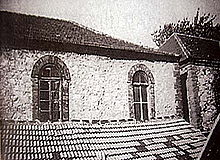
Buildings of the Luoyuan Academy in Jinan
The Luoyuan Academy (Chinese: 泺源书院; pinyin: Luoyuán Shūyuàn) was established in Jinan in the year 1733 by an imperial edict from the Yongzheng Emperor of the Qing Dynasty. The governor of Shandong, Yue Jun (simplified Chinese: 岳浚; traditional Chinese: 岳濬; pinyin: Yuè Jùn), received 1,000 taels of silver (approximately 37 kg) to establish the academy. The name "Luoyuan" (literally "source of the Luo [River]") refers to the original location of the academy near the Baotu Spring. The academy was dedicated to teaching the Chinese classics to the sons of the gentry. In 1881, the American Presbyterian missionaries John Murray (Chinese: 莫约翰; pinyin: Mò Yuēhàn) and Stephen A. Hunter (Chinese: 洪士提反; pinyin: Hóngshì Tífǎn) attempted to purchase a property adjacent to the Luoyuan Academy for use as a chapel. This led to a violent reaction when on July 13, 1881, literati from the Academy incited an attack on the property. The incident, known as the "Jinan Jiaoan" (Chinese: 济南教案; pinyin: Jìnán Jiàoàn), had considerable diplomatic repercussions and it took several years to settle the resulting issues. The Luoyuan Academy was rebuilt extensively in 1896 to become the largest institution of its kind in Shandong. In 1901, it was replaced by the newly founded Shandong College which took over its campus (today the site of the Provincial Bureau of Statistics on Spring City Road, Chinese: 泉城路; pinyin: Quán Chéng Lù).
19th-Century precursor institutions
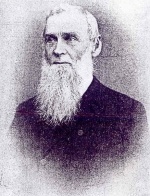
Calvin W. Matteer established Tengchow College in Dengzhou (Penglai).
The earliest precursor institutions that would later be fused into Shandong University were founded by American and English mission agencies: In 1882, Tengchow College was established by Calvin W. Matteer, an American Presbyterian in the area of the modern Penglai on the north-eastern coast of Shandong Peninsula. In 1884, British Baptists established Tsingchow Boy's Boarding School in Qingzhou, also located in northern Shandong, but not directly on the coast.
In 1902, the American and British missionaries agreed to combine their schools in Shandong, and establish an Arts College in Weifang, a Theological College in Zibo, and a Medical College in Jinan. In 1909, all three colleges were consolidated as Shantung Protestant University (later changed to Shantung Christian University). The informal name of the school, "Cheeloo University", was derived from "Qilu", a nickname of Shandong Province coined after the ancient states of Qi (1046 BC-221 BC) and Lu (10th century BC-256 BC) that existed in the area. Jinan was chosen as the new location for the university.
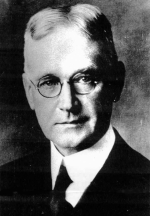
Henry W. Luce led the fundraising for Cheeloo University in Jinan.
A prominent member of Cheeloo University's faculty was Henry Winters Luce (1868–1941), the father of the publisher Henry R. Luce (founder of TIME Magazine, Fortune, and Life). Henry W. Luce initially led the fundraising efforts for the new campus in Jinan (today the Baotuquan Campus of Shandong University); from 1912 to 1915, he raised 300,000 dollars for the new campus in Jinan from donors in the United States . The buildings were designed by the architectural firm of Perkins, Fellows, and Hamilton from Chicago. Henry W. Luce was elected vice-president of Cheeloo University in 1916, but resigned in the following year already, because he felt that he had insufficient support for his vision of a university of major national influence from President E. Percy Bruce.
Cheeloo University particularly expanded in the field of medicine: From 1914-1936, the university built Cheeloo Hospital and between 1916 and 1923, the former Peking Union Medical College, the Medical Department of Nanking University, the Hankow Medical College, and the North China Union Medical College for Women were all moved to Jinan and merged into the Cheeloo University School of Medicine.
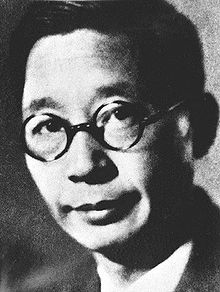
Lao She taught at Cheeloo University and National Shandong University in Qingdao.
The writer Lao She, author of the novel "Rickshaw Boy" and the play "Teahouse", taught at Cheeloo University (1930–1934) as well as at National Shandong University in Qingdao and other universities between 1934 and 1937.
In 1937, when the Japanese occupied northing China during the Second Sino-Japanese War, Cheeloo University evacuated to Sichuan and operated on the campus of West China Union University in Chengdu. In Jinan, the University's hospital remained open with a largely Western staff. During the war, the Japanese military used the entire campus for housing about 1,200 patients along with 600 officers.
During the Korean War (1950–1953), the Chinese government came to regard Christian schools as tools of "American imperialism" and hence embarked on closing them down. Cheeloo University was dissolved in 1952. Its Medical School was fused with Shandong Provincial Medical College and the East China Norman Bethune Medical College to form Shandong Medical College (renamed into "Shandong Medical University" in 1985).
Shandong College (1901)
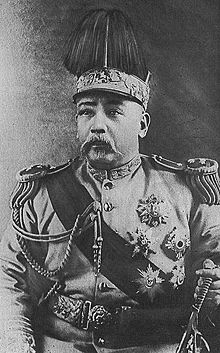
As governor, Yuan Shikai (shown as Emperor of China in 1916) drafted the charter for Shandong College.
The initiative for the founding of Shandong University (as Imperial Shandong Univeristy, Chinese: 山东大学堂; pinyin: Shāndōng Dàxué Táng) in 1901 as a national, modern university came from Yuan Shikai, then the governor of Shandong province. Yuan Shikai was the chief military modernizer of the late Qing Dynasty whose control over a powerful army combined with his personal ambition played a key role in the birth of the Republic of China as well as its descent into warlordism in the early 20th century.
Yuan Shikai had been governor of Shandong Province since December 1899. He had been appointed to this post to quell the Boxer Uprising in the province and to reassure the foreign diplomats in the country who were looking for quick decisive actions against the boxers.
In 1901, Yuan Shikai sent a draft for the university charter (simplified Chinese: 山东大学办学章程; traditional Chinese: 山東大學辦學章程; pinyin: Shāndōng Dàxué Bànxué Zhāngchéng) to the Guangxu Emperor and instructed Li Yukai, the magistrate of Penglai, to start preparations for the university. The draft of the university charter was approved by the emperor in November 1901, shortly after the Boxer Uprising had officially ended with the signing of the Boxer Protocol on September 7, 1901. Shandong College became hence the second modern national university established in the country after Imperial Capital University (simplified Chinese: 京师大学堂; traditional Chinese: 京師大學堂; pinyin: Jīngshī Dàxuétáng) that had been founded in 1898 and later became the forerunner of Peking University. Shandong University's original charter document is now kept in the National Palace Museum in Taipei, Taiwan.
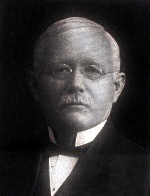
Watson M. Hayes was invited to organize Shandong College and served as its first dean.
Governor Yuan Shikai wanted a prominent position for Western learning in the curriculum of the new college . Hence, he invited the American Presbyterian missionary Dr. Watson McMillan Hayes (Chinese: 赫士; pinyin: Hèshì, 1857–1944) who was then serving as president of Tengchow College in Penglai to help with setting up the new Shandong College and serve as its dean. Hayes arrived in Jinan in July 1901 and started the preparations for the new college . Hayes also published Shandong's first successful daily newspaper and petitioned the Qing court to grant a holiday on Sundays; Shandong College was closed on Sundays right from the start. However, by the end of the year, Hayes and six Chinese Christian teachers he had brought with him had resigned already over disagreements regarding the policy of mandatory Confucius worship for students of the college. Hayes went on to teach the Presbyterian Mission Theological Class in Cheefoo (Yantai) and continued to work as a missionary and educator in Shandong until his death in a Japanese internment camp in Weifang (Wei County) in 1944.
Shandong College occupied the premises of the Luoyuan Academy which had been renovated and extended significantly 5 years earlier. It was opened officially on November 13, 1901 in a ceremony attended by Governor Yuan Shikai. 299 student were enrolled in the first term, of which 120 passed the first examination and 100 were finally admitted. The first faculty had 50 members that also included teachers from overseas, it was later increased to 110. The curriculum contained not only the Chinese classics, Chinese history, but also social sciences, natural sciences, and foreign language with more than 20 subjects being taught in total. At the beginning, the curriculum covered 3 years, but it was later expanded to 4 years.
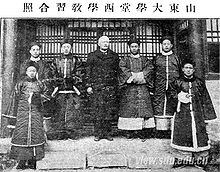
"Western studies" faculty of Shandong College (presumably W. M. Hayes and the six Chinese Christian teachers he had brought with him)
The first president of the new university was Tang Shaoyi. Tang had been educated in the United States (elemetary school in Springfield, Massachusetts, high school in Hartford, Connecticut, and finally one year at Columbia University) and had since then followed a career that had been closely linked to Yuan Shikai: He had been a diplomat with Yuan Shikai's staff in Korea and was appointed head of the Shandong Bureau of Foreign Affairs under governor Yuan Shikai in 1900. He would later become the first Prime Minister of the Republic of China (in March 1912, again under the presidency of Yuan Shikai). As Prime Minister, however, he sided with Sun Yat-sen's Kuomintang against Yuan Shikai and resigned after only three months in office.
In 1904, the Shandong College moved to new premises in the Ganshi Qiao (Chinese: 杆石桥; pinyin: Gānshí Qiáo) area of Jinan (located to the south-west of the historical city center) and changed its name to "Shandong Institution of Higher Learning" (Chinese: 山东高等学堂; pinyin: Shāndōng Gāoděng Xuétáng). In 1911, it changed its name again, this time to the "School of Higher Learning" (Chinese: 山东高等学校; pinyin: Shāndōng Gāoděng Xuéxiào).
National Shandong University in Qingdao (1909-1936)
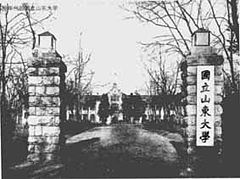
Gate of National Shandong University in Qingdao. The building in the background was originally part of the German Bismarck barracks.
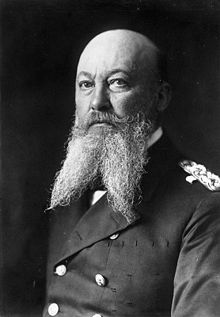
German Admiral von Tirpitz backed a plan that gave the Chinese government a stake in the new university of Qingdao.
The first modern academic institution in the port city of Qingdao was the German-Chinese "Advanced School of Special Sciences of a Special Type" ("Hochschule für Spezialwissenschaften mit besonderem Charakter", Chinese: 特别高等专门学堂; pinyin: Tèbié Gāoděng Zhuānmén Xuétáng) founded on October 25, 1909. In establishing the university, the German authorities took a much more accommodating approach towards the Chinese government than they had taken in the annexation of the territory. The negotiations over the establishment of the school were led by sinologist Otto Franke. Although the German governor Oskar von Truppel vigorously objected to Chinese influence over the school, Franke's collaboration plan received firm backing from Admiral von Tirpitz as well as the German envoy in Beijing. The university operated under the supervision of the German naval administration, but was recognized and supported financially by the Chinese government. The cumbersome name of the school ("spezial" or "tebie", i.e., "special") was chosen at the insistence of the Chinese government to reflect its special status, below the Imperial College in Beijing but above the other provincial Chinese universities. The local informal name for the university was "Hainan School" in reference to an old name for Qingdao. Studies were organized in a "preparatory level" with a six-year (since 1911, five-year) curriculum for students aged 13 to 15 years and an "upper school". Subjects covered included German, history, geography, mathematics, natural history, zoology, botany, health, physics, chemistry, drawing, music, sports, as well as Chinese language and sciences. Whereas engineering and natural sciences were taught in an entirely "Western mode", the Chinese and European approaches were combined in the teaching of the humanities. Religious subjects had been excluded from the curriculum at the request of the Chinese government. The number of students at the school rose to about 400 in 1914, the school assembled a German and a Chinese library with about 5000 and 8000 volumes respectively. School operations ceased with the beginning of the First World War in 1914 and never resumed.
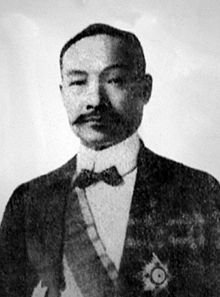
Gao Enhong, first president of the private Qingdao University and governor of the Jiaozhou territory
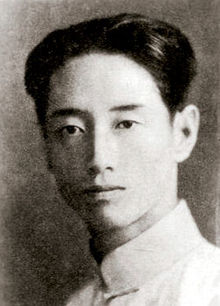
Poet Zang Kejia studied at National Shandong University and later co-edited the "Selected Poems of Chairman Mao".
Qingdao reverted from Japanese to Chinese control in 1922 and Qingdao University was founded as a new private university in August 1924; its first president was Gao Enhong (Chinese: 高恩洪; pinyin: Gāo ēnhóng), the governor of the Jiaozhou territory. The former German-Chinese university was not mentioned during the opening ceremony and it was decided not to hire foreign teachers for the time being. Qingdao University was housed in the former Bismarck barracks that had been constructed for the German troops during the time when Qingdao was part of the German concession in Shandong. The curriculum of Qingdao University was mainly focused on engineering and business administration and a bachelors degree was to be awarded after 4 years of study. Luo Ronghuan, later a marshal of the People's Liberation Army, was among Qingdao University's students. Qingdao University fell on hart times after the Zhili clique of warlords that had ruled Shandong since the takeover from the Japanese unexpectedly lost to its rival Fengtian clique in the Second Zhili-Fengtian War of 1924. Gao Enhong was forced to resign as president of the university and funding dried up.
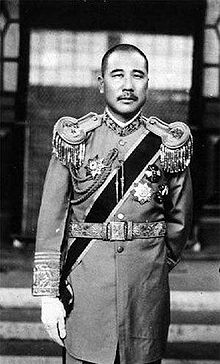
Warlord Zhang Zongchang ordered the fusion of six schools into a provincial Shandong University in Jinan.
The Fengtian clique installed the warlord Zhang Zongchang as ruler of Shandong. Zhang, an illiterate former bandit who had built a reputation mainly for ruthlessness, brutality, and colorful antics, ordered the fusion of six schools into a provincial Shandong University (Chinese: 省立山东大学; pinyin: Shěnglì Shāndōng Dàxué) in Jinan in 1926.
In 1928, the Kuomintang Government in Nanjing regained control of northern China and Shandong through the Northern Expedition. Soon afterwards, preparations commenced for a National University in the province. In August 1928, the government ordered the replacement of the provincial Shandong University with a National University in Shandong. The National University of Qingdao was formally established with an opening ceremony on September 21, 1930. In 1932, it was renamed "National Shandong University". Like Qingdao University, Shandong National University was housed in the buildings of the former Bismarck barracks. The University's chancellor, Yang Zhensheng (Chinese: 杨振声; pinyin: Yáng Zhènshēng), followed the model set by Peking University in establishing an "inclusive" (Chinese: 兼容并包; pinyin: Jiānróng bìngbāo), "scientific and democratic" (Chinese: 科学民主; pinyin: Kēxué mínzhǔ) academic environment. During this period, Shandong National University hired distinguished scientists, scholars and literary figures such as Lao She, Wen Yiduo, Shen Congwen, Liang Shiqiu, the nuclear physicist Wang Ganchang (faculty member from 1934 to 1936), and Tong Dizhou. Poet Zang Kejia, who later co-edited the "Selected Poems of Chairman Mao" (Chinese: 毛主席诗词讲解; pinyin: Máo Zhǔxí Shīcí Jiǎngjiě, 1957), was a student of Wen Yiduo from 1930-1934 in Qingdao.
Second Sino-Japanese War (1937-1945)
In November 1937, a few months after Marco Polo Bridge Incident that had marked the outbreak of a fully-fledged war in July of the same year, National Shandong University was evacuated from Qingdao. The university first moved to Anqing in Anhui Province and soon afterwards to Wanxian in Sichuan Province (today Wanzhou District in Chongqing). Books, equipment, and administrative files were shipped in separate installments and suffered severe loss. Classes resumed in Wanxian in Spring 1938, but were stopped soon after that on orders of the Ministry of Education. Teachers and students were then transferred to the National Central University that had been moved from Nanjing to Chongqing in the previous year. The books and equipment of Shandong University were temporarily placed into storage in the National Central Library, the National Central University, and the National Central Vocational School. After the war, in the spring of 1946, the University moved back to Qingdao.
Post-war period (1945-1965)
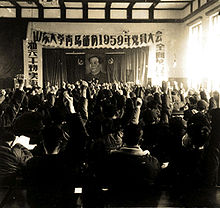
Communist Party Meeting at Shandong University in 1959, during the Great Leap Forward
In 1951, East China University (Chinese: 华东大学; pinyin: Huádōng Dàxué) was merged into Shandong University. In the same year, the university started to publish the "Journal of Shandong University". Cheeloo University was dissolved in 1952 and its Medical School became part of Shandong Medical College. Prior to the Sino-Soviet split, Soviet faculty members worked at Shandong University. In October 1958, the University moved back to Jinan from Qingdao. The marine sciences remained in Qingdao, where they later formed Shandong Ocean University. In Jinan, Shandong University first occupied the Hongjialou Campus. Construction of the new Central Campus commenced in 1959, during the Great Leap Forward and in the year of a great Yellow River flood. Shandong University was added to the list of National Key University on 10 October 1960.
Cultural Revolution (1966-1976)
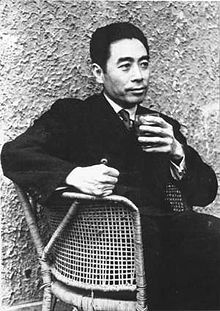
Zhou Enlai intervened to restore Shandong University during the Cultural Revolution.
Starting from early June 1966, schools in Jinan were closed down by strikes as teachers were "struggled against" in the Cultural Revolution. Shandong University was also completely paralyzed by the events. A complete restructuring was imposed on Shandong's university system: According to a resolution passed by Revolutionary Committee of Shandong Province on July 29, 1970, the liberal arts of Shandong University were moved to Qufu and combined with Qufu Normal College to form a new Shandong University. The biology department was moved to Tai'an and merged into the Shandong Agricultural College. The rest of the sciences was to form the Shandong Science and Technology University. In 1971, the university's admission policy was also changed: In order to open the university to workers and peasants, new students were now nominated "by the masses" and then approved by the political leadership and the university. Until 1976, a total of 3267 students who were admitted under this scheme graduated after completing a 2- or 3-year curriculum. Premier Zhou Enlai learned of Shandong University's reorganization in 1973. Although he was already terminally ill with bladder cancer at the time, he intervened and ordered a return to previous structure of the university. As a consequence, all organizational changes imposed by the Revolutionary Committee of Shandong Province were undone in early 1974 already.
Recent history (1980-present)
Shandong University at Weihai was established in 1984. In 1985, Shandong Medical College was renamed Shandong Medical University. From 1986 to 1996, Shandong University underwent a period of rapid academic expansion. By 1997, is contained 14 colleges, 45 schools and offered 56 undergraduate program, 57 master degree programs as well as 17 doctoral degree programs. Shandong University merged with Shandong Medical University and the Shandong University of Technology in 2000. With Shandong Medical University the former campus of Cheeloo University became part of Shandong University (as the West Campus, renamed Baotuquan Campus in 2009). The campus of Shandong University of Technology became the South Campus of Shandong University (renamed Qianfoshan Campus in 2009). Construction of the Xinglongshan Campus (then under the name "New South Campus"), a large new campus located in a mountain valley to the south of Jinan dedicated to education of first- and second-year undergraduate students, began in 2003.
Academic institutions in the history of Shandong University
| Establishment |
建立于 by |
Year established |
位置 |
| Luoyuan Academy (Chinese: 泺源书院; pinyin: Luoyuán Shūyuàn) |
Qing Emperor |
1733 |
Jinan |
Tengchow College of Liberal Arts
(Chinese: 登州文会馆; pinyin: Dēngzhōu Wénhuì Guǎn) |
American Presbyterians |
1882 |
Dengzhou (part of Penglai) |
Tsingchow Boy’s Boarding School
(Chinese: 廣德書院; pinyin: Guǎngdé Shūyuàn) |
British Baptists |
1884 |
Qingzhou |
| Arts College at Weixian |
American Presbyterians & British Baptists |
1902 |
Weixian (now known as Weifang) |
| Theological College at Qingzhoufu |
American Presbyterians & British Baptists |
1902 |
Qingzhoufu (part of Zibo) |
| Medical College |
American Presbyterians & British Baptists |
1902 |
Jinan |
Shandong College
(Chinese: 山东大学堂; pinyin: Shāndōng Dàxué Táng) |
Qing Emperor |
1901 |
Jinan |
Shandong Institution of Higher Learning
(Chinese: 山东高等学堂; pinyin: Shāndōng Gāoděng Xuétáng) |
Qing Emperor |
1904 |
Jinan |
Cheeloo University/Shantung Protestant University (later renamed to Shantung Christian University,
Chinese: 齐鲁大学; pinyin: Qílŭ Dàxué) |
American Presbyterians & British Baptists |
1909 |
Jinan |
Advanced School of Special Sciences of a Special Type
(Hochschule für Spezialwissenschaften mit besonderem Charakter,
Chinese: 特别高等专门学堂; pinyin: Tèbié Gāoděng Zhuānmén Xuétáng) |
German Empire & Qing Dynasty |
1909 |
Qingdao |
School of Higher Learning
(Chinese: 山东高等学校; pinyin: Shāndōng Gāoděng Xuéxiào) |
|
1911 |
Jinan |
| Shandong Provincial Law and Politics College |
|
1914 |
Jinan |
| Shandong Provincial Industrial College |
|
1914 |
Jinan |
| Shandong Provincial Commercial College |
|
1914 |
Jinan |
| Shandong Provincial Medical College |
|
1920 |
Jinan |
| Shandong Provincial College of Mineralogy |
|
1920 |
Jinan |
| Qingdao University |
(Private) |
1924 |
Qingdao |
Shandong Provincial University
(Chinese: 省立山东大学; pinyin: Shěnglì Shāndōng Dàxué) |
Warlord Zhang Zongchang |
1926 |
Jinan |
National Shandong University
(simplified Chinese: 国立山东大学; traditional Chinese: 國立山東大學; pinyin: Guólì Shāndōng Dàxué) |
Republic of China |
1932 |
Qingdao |
| University Property Protection Committee of National Shandong University |
Republic of China |
1938 |
Sichuan |
| Huazhong Construction University |
|
1944 |
Jiangsu |
| Linyi Shandong University |
|
1945 |
Linyi |
| National Shandong University |
Republic of China |
1946 |
Qingdao |
Huadong (East China) University
(Chinese: 华东大学; pinyin: Huádōng Dàxué) |
|
1948 |
Weixian County |
| Shandong University |
|
1951 |
Qingdao |
| Qingdao Medical College |
|
1956 |
Qingdao |
| Shandong College of Oceanography (now Ocean University of China, Qingdao) |
|
1959 |
Qingdao |
Shandong University
(simplified Chinese: 山东大学; traditional Chinese: 山東大學; pinyin: Shāndōng Dàxué) |
|
1958 |
Jinan |
| Liberal Arts Departments are combined with Qufu Teachers College |
Revolutionary Committee of Shandong Province |
1970 |
Qufu |
| Department of Biology becomes part of Shandong Agricultural College |
Revolutionary Committee of Shandong Province |
1970 |
Tai'an |
| Department of Science and the Administration built into Shandong University of Science and Technology |
Revolutionary Committee of Shandong Province |
1970 |
Jinan |
| Shandong University |
P.R. China |
1974 |
Jinan |
Shandong University, Weihai
(Chinese: 威海分校; pinyin: Wēihái Fénxiào) |
|
1984 |
Weihai |
Campuses
Shandong University has a total of seven campuses. All but one of them are located in Jinan, the capital city of Shandong Province. Together they cover an area of 3.8 km². The only campus outside of Jinan is situated in the city of Weihai near the tip of Shandong peninsula.
Current campuses of Shandong University
| Current Name |
Old Name |
Address & 位置 |
| Central Campus (Chinese: 中心校区; pinyin: ZhōngXīnXiàoqū) |
East New Campus (Chinese: 东新校区; pinyin: DōngXīnXiàoqū) |
27 Shanda Nanlu, Jinan, 36°40′18.64″N 117°3′14.34″E / 36.6718444°N 117.0539833°E / 36.6718444; 117.0539833 |
| Hongjialou Campus (Chinese: 洪家楼校区; pinyin: Hóngjiālóu Xiàoqū) |
East Old Campus (Chinese: 东老校区; pinyin: DōngLǎoXiàoqū) |
5 Hongjialou, Jinan, 36°41′9″N 117°3′41″E / 36.68583°N 117.06139°E / 36.68583; 117.06139 |
| Baotuquan Campus (Chinese: 趵突泉校区; pinyin: Bàotūquán Xiàoqū) |
West Campus (Chinese: 西校区; pinyin: Xī Xiàoqū), formerly the campus of Cheeloo University |
44 Wenhua Xilu, Jinan, 36°39′11″N 117°0′43″E / 36.65306°N 117.01194°E / 36.65306; 117.01194 |
| Qianfoshan Campus (Chinese: 千佛山校区; pinyin: Qiānfóshān Xiàoqū) |
South Campus (Chinese: 南校区; pinyin: Nán Xiàoqū), formerly the campus of the Shandong University of Technology |
17923 Jingshi Road, Jinan, 36°39′2″N 117°1′2″E / 36.65056°N 117.01722°E / 36.65056; 117.01722 |
| Xinglongshan Campus (Chinese: 兴隆山校区; pinyin: Xīnglóngshān Xiàoqū) |
New South Campus (Chinese: 南新区; pinyin: Nán Xīn Qū) |
2550 Erhuan Donglu, Jinan, 36°35′55″N 117°2′38″E / 36.59861°N 117.04389°E / 36.59861; 117.04389 |
| Qilu Software College Campus (Chinese: 齐鲁软件学院; pinyin: Qǐlú Ruánjiàn XuěYuàn) |
|
Shunhua Road, Jinan, 36°40′0″N 117°7′57″E / 36.666667°N 117.1325°E / 36.666667; 117.1325 |
| Shandong University at Weihai (Chinese: 威海分校; pinyin: Wēihái Fénxiào) |
|
180 Wenhua Xilu, Weihai, 37°31′49″N 122°3′19″E / 37.53028°N 122.05528°E / 37.53028; 122.05528 |
Central 校园
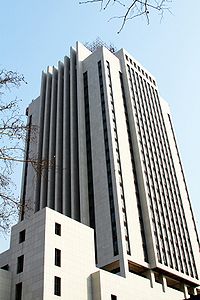
New Building under construction on the Central Campus in January 2010
Construction of the Central Campus commenced in 1959, about a year after the University had moved back from Qingdao to Jinan and during a time that coincided with the Great Leap Forward, the Great Chinese Famine, as well as a devastating flood of the Yellow River (in July 1959). The Central Campus houses the central administration, the main university library, a large dining hall, as well as several student dormitories. The central campus is home to the schools of Chemistry and Chemical Engineering, Environmental Engineering, Economics, History and Culture, Marxism-Leninism, Life Sciences, Mathematics and System Science, Literature and Journalism and Communication, as well as Information Science and Engineering. One of Shandong University's hotels (Chinese: 山东大学学术交流中心; pinyin: Shāndōng Dàxué Xuéshù Jiāoliú Zhōng xīn, or for short: "Xueren Dasha", Chinese: 学人大厦; pinyin: Xuérén Dàshà) is also located on the central campus.
Hongjialou 校园
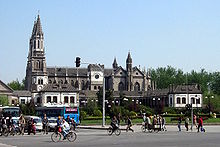
Sacred Heart Cathedral on Hongjialou Square
The Hongjialou Campus derives its name from the Hongjialou Square and is located to the north and east of Hongjialou Square and the Sacred Heart Cathedral (Chinese: 洪家楼耶稣圣心主教座堂; pinyin: Hóng Jiā Lóu Yē Sū Shèng Xīn Zhŭ Jiào Zuò Táng). The first construction on the campus dates back to 1936 when it was used for the Jinan Yifan Girls' Middle School (Chinese: 懿范女子中学; pinyin: Yìfàn Nǚzǐ Zhōngxué) that was operated by Franciscan sisters (Chinese: 艾修女; pinyin: ài xiū nǚ) of the Archdiocese of Jinan. In 1948, the Yifan Girls' Middle School was combined with Liming Middle School (Chinese: 黎明中学; pinyin: Límíng Zhōngxué) and its former campus became part of the Shandong Agricultural Institute that used it until 1958, when the Institute moved to Tai'an. In October 1958, the Hongjialou Campus became Shandong University's first Campus after the University moved back to Jinan from Qingdao. The Hongjialou Campus houses the Schools of Law, Foreign Languages and Literature, Physics, Fine Arts, Physical Education, Philosophy and Social Sciences, as well as Political Science and Public Administration.
Baotuquan 校园
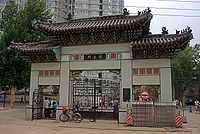
Alumni Gate, the former main entrance to Cheeloo University
The Baotuquan Campus is the former campus of Cheeloo University and was established in 1909. The design for the campus was made by Perkins, Fellows and Hamilton, an architectural firm from Chicago renown for its school buildings in the "Prairie School" style. The American architects attempted to include Chinese architectural features into the design of the buildings on the new Cheeloo University campus in Jinan. They did, however, mistakenly assume that the roof shape was the only distinguishing feature of Chinese architecture. As a result, the buildings feature Chinese-style roofs on buildings that lack the matching support elements such as wooden Dougong brackets that characterize Chinese architecture. Historical buildings on the Baotuquan Campus include the Bergen Science Hall (Chinese: 柏尔根楼; pinyin: Bǎiěrgēn Lóu, formerly for Chemistry and Biology), the Matteer Science Hall (formerly for Physics and Physiology), the McCormick Hall, and the Alumni Gate (the former main entrance, construction completed on June 17, 1924). At present, Baotuquan Campus houses the schools of public health, nursing, dentistry, pharmacy, and medicine.
Qianfoshan 校园
The Qianfoshan Campus was established in 1949 and served as the campus of Shandong University of Technology. It became a part of Shandong University when Shandong University of Technology was merged into Shandong University in July 2000. The campus has a total area of about 420,000 square meters and remains exclusively dedicated to engineering. It is home to the schools of Materials Science and Engineering, Electrical Engineering, Mechanical Engineering, Computer Science and Technology, Control Science and Engineering, Energy and Power Engineering, Physical Education, as well as Civil Engineering.
Xinglongshan 校园
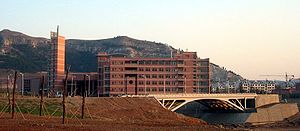
Xinglongshan Campus in April 2005
The Xinglongshan Campus is the newest campus of Shandong University and also its largest campus in Jinan with an area of about 769,000 square meters. Construction of the campus started in March 2003 and its first facilities were ready for use in August 2004. The campus is used to house first- and second-year students of nine different departments. The Xinglongshan Campus also houses a Student Associations Activity Center with a total floor space of about 2000 square meters .
Qilu Software College 校园
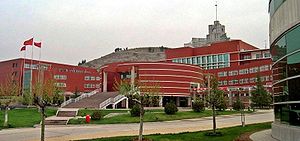
Qilu Software College Campus in April 2005
The Qilu Software College Campus is home to the School of Computer Science and Technology as well as to the University's Software College. Campus construction of started in July 2001 and the campus now has a total area of about 267,000 square meters.
Shandong University at Weihai
Shandong University at Weihai was established in 1984, its campus covers a total area of about 1 million square meters, making it the largest campus of Shandong University. Shandong University at Weihai is organized in 13 departments that include the College of Korean Studies, the Business School, the Law School, the School of Journalism and Communication, the Art Institute, the College of Ocean Science, the School of Information Engineering, the School of Electrical and Mechanical Engineering, the Institute of Space Science and Physics, the Mathematics and Statistics Institute, the School of International Education, and the College of Vocational and Technical Training. To the west of the Weihai campus lies the Shandong University Academic Center, a beach-front hotel and conference center.
Administration
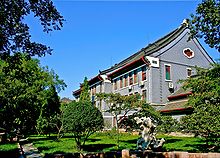
Historical building on the Baotuquan Campus
At the top level, Shandong University is organized by subject area into 31 faculties that are referred to as "Schools" (Chinese: 学院; pinyin: Xuéyuàn) as well as a graduate school. Each school is headed by a dean and may be divided further into departments headed by a chair person. Academic programs are offered in 11 main disciplines: philosophy, economics, law, literature, history, natural sciences, engineering, management, medicine, education, and military science. There are 104 undergraduate degree programs, 209 master's degree programs, and 127 doctoral degree programs. In addition, there are 7 professional master's degree programs in law, business management, engineering, clinical medicine, public health, dentistry, and public administration.
The student population is around 57,500 full-time students, of which 14,500 are postgraduate students, and over 1,000 are foreign students (data from 2009) .
The major research efforts at Shandong University are organized in 34 national, provincial, and ministerial key academic disciplines, 2 national key research labs, 21 provincial and ministerial key research labs, a national engineering and technology promotion center, 10 provincial technology research centers, 3 national basic scientific research and personnel development bases; 3 social science key research bases approved by Ministry of Education; and 3 national fundamental science personnel development bases. Among its faculty are 23 members (including adjuncts) of the Chinese Academy of Sciences and the Chinese Academy of Engineering. Three general hospitals, including Qilu Hospital, and 12 teaching hospitals are affiliated with the university. The university library houses a collection of over 3,550,000 items.
Schools and Departments
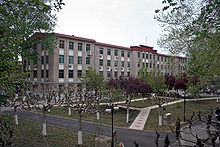
Old building of the School of Physics on the Hongjialou Campus in 2006
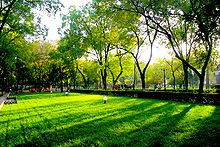
Lawn and trees on the central quadrangle of the Baotuquan Campus
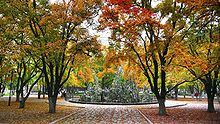
Autumn colors on the Baotuquan Campus
- School of Business Administration
- School of Chemistry and Chemical Engineering
- School of Civil Engineering
- School of Computer Science and Technology
- School of Control Science and Engineering
- School of Dentistry
- School of Economics
- School of Electrical Engineering
- School of Energy and Power Engineering
- School of Environmental Science and Engineering
- School of Fine Arts
- School of Foreign Languages and Literature
- School of History and Culture
- School of Information Science and Engineering
- School of Law
- School of Life Science
- School of Literature and Journalism
- School of Marxist Theory Education
- School of Materials Science and Engineering
- School of Mathematics and System Sciences
- School of Mechanical Engineering
- School of Medicine
- School of Nursing
- School of Pharmacy
- School of Philosophy and Social Development
- School of Physical Education
- School of Physics
- School of Political Science and Public Administration
- School of Public Health
- General Study Program
International Cooperation and Exchange
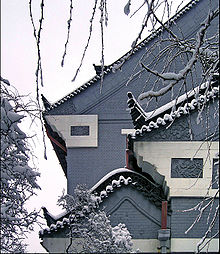
Building on the Baotuquan Campus in winter.
.
Shandong University has established a broad international network for educational cooperation and has signed exchange agreements with over 70 universities from over 50 countries. Among its faculty are international researchers and scholars, who either visit for a short term (less than 1 month, 160 visitors in 2009), a medium term (less than half a year, 70 visitors in 2009), or for the long term (more than half a year, 80 visitors in 2009). Of the 80 long-term international faculty members , were 30 language scholar who were teaching languages such as English, Japanese, Korean, French, German, Spanish, and Russian. The others were active in disciplines such as philosophy, biology, chemistry, physics, law, international politics and economics, as well as Chinese classics and traditional philosophy.
In 2006, Shandong University created a joint urban research center with the University of Cincinnati in the United States, and an ongoing presence on each other's campus.
About 1500 international students from about 40 countries come to study at Shandong University each year. An international student population numbering more than 1000 can be found on campus at any given time during the semester. Most of these international students come from Asian and African countries, but there is also a number of students are from Europe, the United States, Canada, and Australia. Since 1980, Shandong University has received more than 10,000 students from over 60 countries in total. Particularly popular study subjects are Chinese language and culture, but also economics and medicine.
Shandong University is also participating in a number of international short term exchange programs and receives approximately 2500 international student visitors from such programs per year.
Research Centers
State Key Laboratories
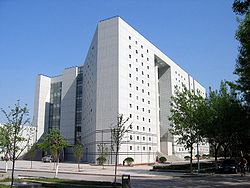
Building of the State Key Laboratory for Crystal Materials
- State Key Laboratory for Crystal Materials
- State Key Laboratory for Microbial Technology
National Research Center
- National Glycoengineering Research Center
Ministry of Education Key Laboratories
- Key Laboratory for Colloid and Interface Chemistry
- Key Laboratory for Liquid Structure and Heredity of Materials
- Key Laboratory for Experimental Teratology
- Key Laboratory for Cardiovascular Remodelling and Function Research
Ministry of Health Key Laboratories
- Key Laboratory for Otolaryngology
Key Research Base of the Ministry of Education in Humanities and Social Sciences
- Center for Zhouyi and Ancient Chinese Philosophy
- Center for Judaic and Inter-Religious Studies
- Institute for Literary Theory and Aesthetics
- Institute for Contemporary Socialism
National Research Institutes
- Institute for Crystal Materials
- Institute for Microbiology
- Institute for Infrared and Remote Sensing Technology
Research Centers of Shandong Province
- Geotechnical and Structural Engineering Research Center
- Laboratory for Risk Analysis and Random Calculus
- Institute for Religion, Science, and Social Studies
- Number Theory at Shandong University
- High Energy Physics Group
- Oriental Archaeology Research Center
- Center for Economic Research
- Center for Health Management & Policy
- Center for European Studies
- Center for Space Thermal Science
- Center for Japanese Studies
- Key Laboratory for Otolaryngology
- Modern Logistics Research Center
- Institute of ECIWO Biology
University hospitals
Shandong University Qilu Hospital
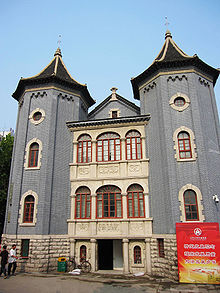
The "Republican Building" of Qilu Hospital was built in 1914 and inaugurated by military governor Jin Yunpeng.
Qilu Hospital was first established as the hospital of Cheeloo University. Construction started in 1914 and was supervised by Harold Balme (1878–1953), a British physician from King's College Hospital in London, who would later serve as the third president of Cheeloo University (from 1921 until 1927). The first building of the new hospital (today known as the "Republican Building") was inaugurated on September 27, 1915 by the military governor of Shandong, Jin Yunpeng. About 20 years later, the hospital moved to a new building (completed in 1936) and the old building was used by Cheeloo University's School of Medicine. Today, the Shandong University Qilu Hospital as a total capacity of 1,800 beds and treats more than more than 1.9 million outpatient treatments per year. It has departments include cardiology, internal medicine, hematology, gynecology and obstetrics, otolaryngology, general surgery, neurosurgery, and pediatrics. The hospital is located at Wenhua West Road 107 in Jinan.
Second Hospital of Shandong University
The Second Hospital of Shandong University has a capacity of about 1200 beds and has departments for neurosurgery, orthopedic surgery, and internal medicine. The hospital is managed by the National Medical Department and affiliated with Shandong University, it is located at Beiyuan Street 247 in Jinan.
Stomatology Hospital of Shandong University
The Stomatology Hospital of Shandong University was founded in 1977. It has 105 employees and is organized into four research centers and two laboratories. It is located at Wenhua West Road 44 in Jinan.
List of university presidents
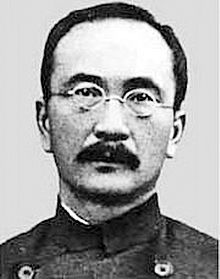
Tang Shaoyi, studied at Columbia University, became first president of Shandong College and later Prime Minister of the Republic of China.
- Tang Shaoyi, 1901, later Prime Minister of the Republic of China (1912)
- Wang Shoupeng, 1926–1927
- Yang Zhensheng, 1930–1932
- Zhao Taimou, 1932–1936 and 1946–1949
- Lin Jiqing, 1936–1946
- Hua Gang, 1951–1955
- Chao Zhefu, 1956–1958
- Cheng Fangwu, 1958–1974
- Wu Fuheng, 1979–1984
- Deng Conghao, 1984–1986
- Pan Chengdong, 1986–1997
- Zeng Fanren, 1998–2000
- Zhan Tao, 2000–2008
- Xu Xianming, 2008–present
Notable faculty and alumni
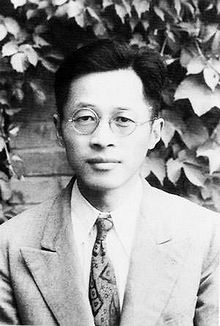
Wang Ganchang was a PhD student of Lise Meitner (co-discoverer of nuclear fission) at the Humboldt University of Berlin and became one of the fathers of China's atomic bomb.
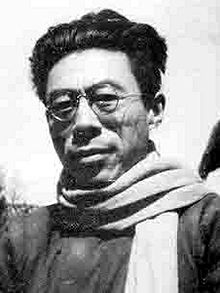
Wen Yiduo, studied at the Art Institute of Chicago, became an acclaimed poet, and was assassinated by Kuomintang agents.
- Feng Yuanjun (1900–1974), writer and scholar of Chinese classical literature and literary history
- Gao Heng (高亨, 1900-1986), pioneer in the modern interpretation of the Book of Changes, corresponded with Mao Zedong
- Ji Xianlin (1911–2009), linguist, paleographer, historian, writer
- Jīn Xuěfēi (1956-, pen name Ha Jin), writer, publishes in English, winner of the American National Book Award (1999)
- Lao She (1899–1966), writer, author of the novel "Rickshaw Boy"
- Li Congjun (1949-), president of Xinhua News Agency (since 2008)
- Liang Shiqiu (1903–1987), writer and translator, translated the complete works of Shakespeare and George Orwell's Animal Farm into Chinese
- Luo Ronghuan (1902–1963), Marshall of the People's Liberation Army, served as security chief during the Long March
- Peng Shige (1947-), mathematician renown for contributions to stochastic analysis and mathematical finance
- Shen Congwen (1902–1988), writer renown for combining vernacular and classical Chinese writing techniques
- Tong Dizhou (1902–1979), embryologist and vice president of the Chinese Academy of Science
- Wang Ganchang (1907–1998), nuclear physicist (student of Lise Meitner) and one of the principal contributors to the Chinese nuclear deterrent
- Wang Tongzhao (王统照, 1897–1957), writer
- Wang Xiaoyun (1966-), mathematician, demonstrated collision attacks against commonly used hash functions
- Wen Yiduo (1899–1946), poet and scholar, poetry influenced by Western models, collections Hongzhu (紅燭, "Red Candle") and Sishui (死水, "Dead Water")
- Wu Aiying (1951-), Minister of Justice of China (since 2005)
- Xiang Huaicheng (1939-), economist and former Minister of Finance of China
- Zang Kejia (1905–2004), poet, chief editor of Poetry magazine, co-edited the "Selected Poems of Chairman Mao"
- Zhao Xiao (1967-), economist, argued that China’s economy would benefit from the spread of Christianity
- Zhou Ming-Zhen (1918–1996), paleontologist, known for his work on early tertiary mammals
更多
Other academic institutions in Jinan (not part of Shandong University):
- Shandong Normal University (Chinese: 山东师范大学; pinyin: ShāndōngShīfàn Dàxué)
- Shandong Jianzhu University (Chinese: 山东建筑大学; pinyin: Shāndōng Jiànzhù Dàxué)
- Shandong Jiaotong University (Chinese: 山东交通学院; pinyin: Shāndōng Jiāotōng Xuéyuàn)
- Shandong Economic University (Chinese: 山东经济学院; pinyin: Shāndōng Jīngjì Xuéyuàn)
- Shandong University of Finance (Chinese: 山东财政学院; pinyin: Shāndōng Cáizhèng Xuéyuàn)
- Shandong University of Traditional Chinese Medicine (Chinese: 山东中医药大学; pinyin: Shāndōng Zhōngyīyào Dàxué)
- Shandong University of Arts (Chinese: 山东艺术学院; pinyin: Shāndōng YìshùXuéyuàn)
- University of Jinan (simplified Chinese: 济南大学; pinyin: Jǐnán Dàxué)
参考文献
- ^ "A Century-Old University Overflowing with Vigor" - official website of Shandong University (in Chinese)
- ^ "About Shandong University" - official website of Shandong University (in Chinese)
- ^ "History" - official website of Shandong University (in Chinese)
- ^ "Shantung Christian University" - from: "Hallowed halls: Protestant colleges in old China" by Tess Johnston, Deke Erh, Martha Smalley, and Tung-Chung Yee, Old China Hand Press, Hong Kong, 1998
- ^ "National Key Universities" - Baidu Baike Online Encyclopedia (in Chinese)
- ^ "Profile of Shandong University" - official website of Shandong University (in Chinese)
- ^ "Top 100 Chinese University Rankings 2009 announced in Beijing University, Qinghua University and Fudan home in the first three" - CUAA website (in Chinese)
- ^ Wu Shu Lian, "2008 Chinese University Evaluation Report" (in Chinese)
- ^ "Luoyuan Academy" - Online Article at Hudong.com (in Chinese)
- ^ United States. Dept. of State (1881): "Papers relating to the foreign relations of the United States"
- ^ William Joseph Haas (1996): "China voyager: Gist Gee's life in Science", M.E. Sharpe
- ^ Lao She, "Rickshaw: The Novel Lo-t'o Hsiang Tzu", University of Hawaii Press, 1979, Translator's Introduction
- ^ Jessie Gregory Lutz, China and the Christian Colleges, 1850-1950, Cornell University Press, Ithaca, NY 1971
- ^ Suisheng Zhao, "Power by design: constitution-making in Nationalist China", University of Hawai'i Press, Honolulu, 1996, pg. 22
- ^ Lanxin Xiang, "The origins of the Boxer War: a multinational study", Routledge, London, 2002, pg. 117
- ^ John J. Heeren (1940): On the Shantung Front, The board of foreign Mission of the presbyterian church in the United States of America
- ^ Qu Zheng-Min, "China's first university"
- ^ Ulrich van der Heyden (Editor), Holger Stoecker (Editor) 2005: "Mission und Macht im Wandel politischer Orientierungen", Franz Steiner Verlag
- ^ Arthur Judson Brown (1907): "New forces in old China: an inevitable awakening" Young People's Missionary Movement, New York, 2nd edition
- ^ Ke-wen Wang, "Modern China: an encyclopedia of history, culture, and nationalism", Routledge, London, 1997, Pg. 348
- ^ George Steinmetz (2007): The Devil's Handwriting: Precoloniality and the German Colonial State in Qingdao, Samoa, and Southwest Africa (Chicago Studies in Practices of Meaning), University Of Chicago Press
- ^ Andreas Steen (2006): Deutsch-chinesische Beziehungen 1911-1927, Akademie Verlag (in German)
- ^ Chun-Shik Kim (2004): Deutscher Kulturimperialismus in China: Deutsches Kolonialschulwesen in Kiautschou (China) 1898-1914, Franz Steiner Verlag (in German)
- ^ Harold Miles Tanner (2009): "China: A History", Hackett Pub. Co.
- ^ "CHINA: Basest War Lord", Time Magazine, Mar. 07, 1927
- ^ Jinan City Government online records for 1966 (1st half, in Chinese)
- ^ Jinan City Government online records for 1970 (in Chinese)
- ^ Jinan City Government online records for 1974 (in Chinese)
- ^ information base of the Shandong Government
- ^ Jeffrey W. Cody (1996): "Striking a harmonious chord: Foreign Missionaries and Chinese-style Buildings, 1911-1949, Architronic 5(3)
- ^ Shandong University of Technology - online article at baike encyclopedia (in Chinese)
- ^ "Overiew of Shandong University's New South Campus" - official website of Shandong University (in Chinese)
- ^ A Visit to the New District Construction Management Office - official website of Shandong University (in Chinese)
- ^ "Shandong University Xinglongshan Campus Student Activity Center officially opened" Shandong University Alumni Network (in Chinese)
- ^ "College Profile" - website of the Shandong University Software College (in Chinese)
- ^ "Shandong University at Weihai - School Profile", official website of Shandong University at Weihai (in Chinese)
- ^ Trip to Promote UC's China Strategy Pays Off in First Comprehensive Agreement With Chinese University
- ^ "Obituary - Harold Balme, O.B.E., M.D., F.R.C.S." British Medical Journal, Feb 28, 1953, p. 511-512
- ^ "About Qilu Hospital" - official website of Qilu Hospital (in Chinese)
- ^ "Second Hospital of Shandong University" - official website (in Chinese)
- ^ "Stomatology Hospital of Shandong University" - official website (in Chinese)
External links
 |
Wikimedia Commons has media related to: Shandong university |
|
|
This article contains Chinese text. Without proper rendering support, you may see question marks, boxes, or other symbols instead of Chinese characters. |
- Shandong University website (Chinese)
- Shandong University website (English)



